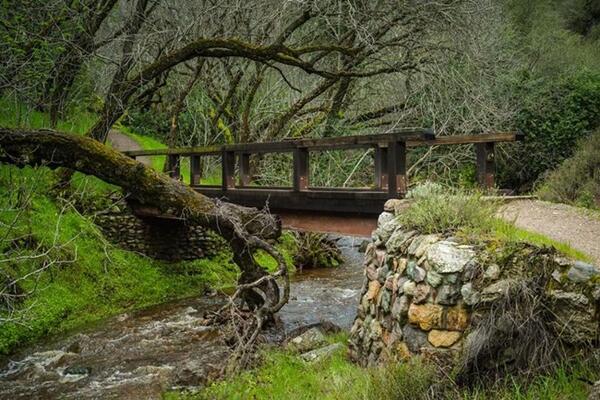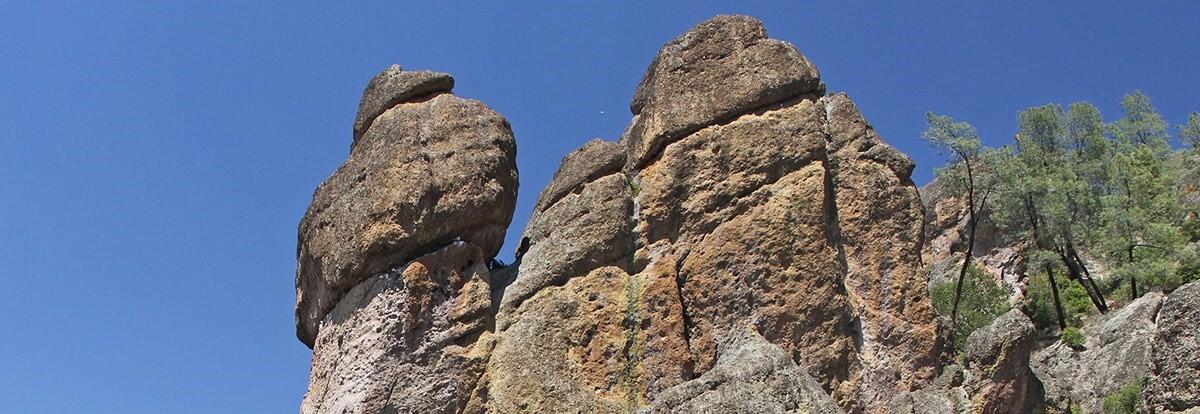Ecology of Pinnacles National Park
Learn about the ecology of Pinnacles National Park.

Pinnacles National Park is located in central California, east of the Salinas Valley and southeast of San Jose. Though it’s been an official national monument since 1908, Pinnacles is a relatively new addition to the National Parks system, only being added as an official National Park in 2013. Pinnacles is also amongst the smallest of the National Parks, only encompassing a little over 26,000 acres of land (for comparison, Yellowstone National Park is over 2.2 million acres). However, while Pinnacles might be younger and smaller than many other parks, it’s just as ecologically diverse.
Biotic Communities and Plant Species
The park’s unique location just west of the San Andreas fault has contributed to its striking geologic features, including rock spires and cave formations. These features have in turn contributed to the large difference in elevational limits within the park, with a minimum and maximum elevation of 824 feet and 3,304 feet, respectively. As the elevation increases, the climate tends to change from warm and dry to cooler and wetter conditions. The highly varied climate conditions in the park have led to the formation of several different biotic communities, (groups of organisms that interact with each other). Biotic communities are typically defined by the types of plants present and the abiotic conditions. Pinnacles National Park contains five plant communities: chaparral, woodland, riparian, grassland, and rock and scree.

Chaparral
The chaparral biotic community is the most abundant throughout Pinnacles National Park, covering 82% of its land. Though chaparral is considered just one biotic community, it contains a lot of variation. Throughout the park, chaparral can be found in areas of varying moisture levels, temperatures, and soil depth, leading to different distributions of species. For example, within a chaparral community, more species may be found on moister north-facing slopes of hills than drier south-facing slopes. Overall, however, many species in the chaparral zones need to adapt for hot, dry summers and natural fires. These adaptations include waxy coating on leaves, water storage structures, and dormancy during summer to prevent water loss. Some species even rely on fire to stimulate the germination of seeds. The most common plant in the chaparral community is the chamise (Adenostoma fasciculatum), a small shrub with needle-like leaves and white flowers. Other common plants in the chaparral community include manzanita (Arctostaphylos spp.), holly-leaved cherry (Prunus ilicifolia), mountain mahogany (Cercocarpus betuloides), and buck brush (Ceanothus cuneatus var. cuneatus).
Woodland
The oak woodland biotic community, also sometimes referred to as the oak savannah, is the second most dominant community in Pinnacles, covering 10% of the total area. The most defining species of this community is the blue oak (Quercus douglasii). The understory consists mostly of non-native grasses, but native perennial and annual species can still be found throughout. Other common plants in this community include the gray pine (Pinus sabiniana), the California buckeye (Aesculus californica), and the valley oak (Quercus lobata).

Riparian
Though the riparian community only compose a small part of the park, it’s responsible for much of the plant and wildlife diversity. Riparian communities are found alongside creeks and streams in the deep valleys and canyon bottoms of Pinnacles National Park. In an otherwise hot and dry park, the streams found by riparian communities provide water and refuge to wildlife, including fish, birds, mammals, amphibians (including the threatened California red-legged frog), and invertebrates. Common plant species in riparian areas include deciduous and evergreens such as the western sycamore (Platanus racemosa), Fremont’s cottonwood (Populus fremonti), and the California buckeye (Aesculus californica). Other common species include oaks, willows (Salix spp.), and mule fat (Baccharis salicifolia ssp. salicifolia). Because many species are reliant on these wetland habitats, it’s especially important to monitor and conserve riparian communities to protect species diversity.
Grassland
Grassland is another biotic community that only is only found in a small portion of Pinnacles National Park. Much of the grassland ound throughout the park today is the result of the prescribed burning of chaparral communities under fire management plans of the 1970’s, leading to an influx of non-native species. The relatively shallow soil level allows only certain species to become established. Common grasses include native fiddleneck (Amsinckia intermedia), native lomatiums (Lomatium spp.), non-native filaree (Erodium spp.), and both native and non-native species of brome (Bromus spp.).

Rock and Scree
Rock and scree, while the least common community in the park, is perhaps the most recognizable, marked by rock formations including spires and pinnacles, the namesake of the park. The community is defined by little to no soil, preventing most plant species from establishing. However, some species have been able to survive on the rocky surfaces, including bitter root (Lewisia rediviva) and two-leaved onion (Allium cratericola).
Lichens
Lichens are a mutualistic symbiotic interaction between a fungus and algae that are found abundantly throughout Pinnacles National Park. Lichens play an important ecological role in many of the above biotic communities. In chaparral and woodland communities, lichens found in the soil contribute to soil stabilization, and lichens found on tree trunks provide food and shelter for many insects and nesting material for birds and mammals. Lichens additionally contribute greatly to nutrient cycling throughout ecosystems and humidity control.

Animals
The varied topography and biotic communities provide a home for thousands of diverse animal species across all major clades (groups of organisms).
Birds
Since 1908, over 160 species of bird have been spotted throughout the park. Some abundant species include vultures, raptors, falcons, eagles, woodpeckers, and warblers.

Perhaps the most well-known bird species in Pinnacles National Park is the California condor (Gymnogyps californianus). The California condor is the largest land bird in North America with wingspans up to 9.5 feet, and their lifespans are believed to be over 60 years. While once dominant throughout all of North America, their population plummeted due to hunting, habitat fragmentation, and lead poisoning from the biomagnification of lead from consuming the carcasses of animals who have been shot with lead bullets. At their most endangered in the 1980s, there were only an estimated 22 California condor individuals remaining in the wild. However, after an intensive recovery program that included capturing all living individuals to be placed in a captive breeding program, the number of California condors has steadily increased. Captive California condors were released in five locations throughout the western half of North America, including Pinnacles National Park. Since then, Global Positioning System (GPS) data has been used to track and manage these populations. There are now an estimated 488 individuals as of 2018, but they are still threatened pollution, power lines, and lead poisoning.

Mammals
There have been 48 species of mammals across seven different orders documented at Pinnacles National Park. Commonly found species include black-tailed deer, bobcats, gray foxes, raccoons, rabbits, ground squirrels, chipmunks, and bats. Some less frequently spotted species include badgers, coyotes, and mountain lions. Three of the 48 observed species are non-native, including the house mouse, opossum, and feral pig. While house mice and opossums are rarely sighted and are thought to have little impact on local ecosystems, the feral pigs have significantly damaged vegetation. This prompted the construction of a fence around the park’s perimeter to prevent future pig invasions.
Reptiles and Amphibians
Pinnacles National Park is home to 23 species of reptiles, including eight lizard, 14 snake, and one turtle species. While many lizard and snake species are often active and commonly found, the South Western pond turtle (Actinemys pallida) and desert night lizard (Xantusia vigilis) are rarer.

Pinnacles also houses eight species of amphibians. While the hot and dry climate of central California seems unsuitable for water-dependent amphibians, they are able to survive in the moist climate of the riparian areas. Several species, including the pacific tree frog (Pseudacris regilla), the threatened California red-legged frog (Rana draytonii), and western toad (Bufo boreas), take advantage of permanent streams and ponds found in the canyon bottoms. Other species, such as the arboreal salamander (Aneides lugubris), ensatina (Ensatina eschscholtzii), and the Gabilan slender salamander (Batrachoseps gavilanensis) are terrestrial, meaning they spend their entire lives on land. In order to reproduce, they lay their eggs in moist areas such as inside decaying logs.
Fish
Pinnacles National Park only contains one native fish species, the three-spined stickleback (Gasterosteus aculeatus). The tree-spined stickleback is a small fish, measuring only three inches in length when fully grown. In the past, non-native fish who invaded the area, including catfish and sunfish, have been removed using electroshocking. Currently, the only non-native fish species in the park is the mosquitofish.

Insects
While often overlooked, insects account for much of the biodiversity at Pinnacles National Park. Thousands of invertebrate species have been identified in the park, including 70 butterflies, 500 moths, and 250 aquatic invertebrates. There are also over 400 species of bees, making Pinnacles an area with one of the highest bee diversities in the world. These insects act as important pollinators, a necessary process in the reproduction and proliferation of many plant species. Other invertebrates found throughout the park include tarantulas and ladybugs during their bi-annual migrations.

